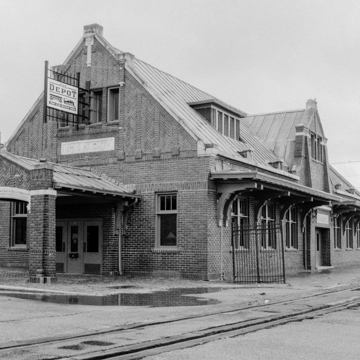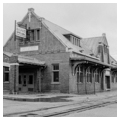You are here
Old Soo Depot Transportation Museum and History Research Center (Soo Line Passenger Depot)
In 1893, the Minneapolis, St. Paul and Sault Ste. Marie Railroad (the Soo) built a line through Minot. The Soo desired a westward line into the agricultural lands of Dakota Territory in order to increase business and to connect with the Canadian Pacific Railway northwest of Minot. Furthermore, the Soo’s presence and competition with the GN significantly influenced Minot’s spatial development when population and business again increased in the early twentieth century.
Featuring Flemish bond brick and handsome brick herringbone patterning, banding, dentils, and paneling, the Arts and Crafts-influenced depot was the Soo Line’s second passenger facility in Minot. The depot has shed-roof dormers in the standing-seam copper roof, elaborately crafted wooden brackets, and pairs of windows with vertical-lite transoms painted a distinctive orange color. The interior is highlighted by a vaulted, coffered plaster ceiling. Adaptive use of this building in the late 1970s as a commercial real estate office was one of the state’s earliest preservation success stories. The building survived the flood of 2011 and continues as a popular attraction highlighting the railroad’s importance in Minot. The museum and regional history research center are again in active public use.
Writing Credits
If SAH Archipedia has been useful to you, please consider supporting it.
SAH Archipedia tells the story of the United States through its buildings, landscapes, and cities. This freely available resource empowers the public with authoritative knowledge that deepens their understanding and appreciation of the built environment. But the Society of Architectural Historians, which created SAH Archipedia with University of Virginia Press, needs your support to maintain the high-caliber research, writing, photography, cartography, editing, design, and programming that make SAH Archipedia a trusted online resource available to all who value the history of place, heritage tourism, and learning.


















